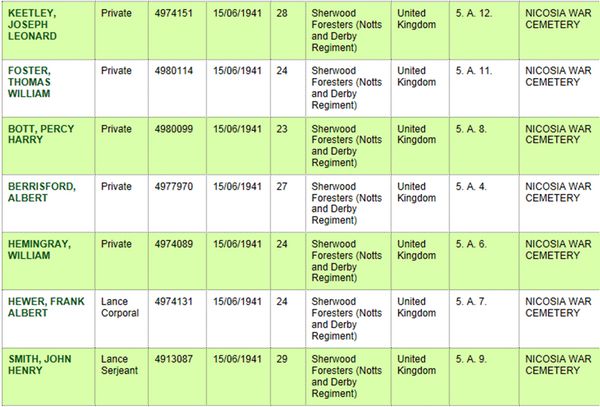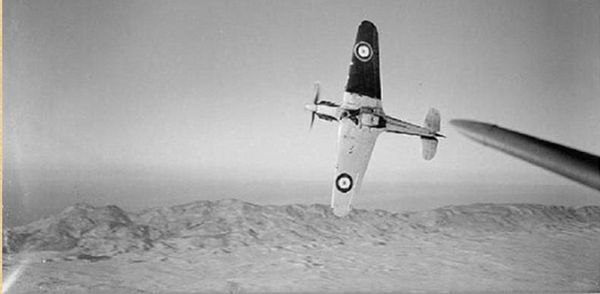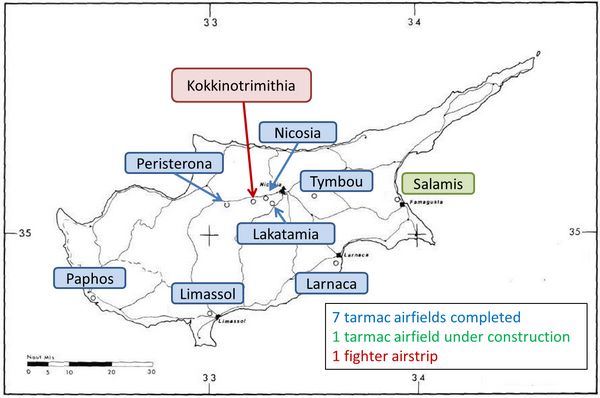The First Years
In October 1939, shortly after the outbreak of WW2, the building of three 'all weather runways' began. This major project was completed by May 1940.
However, there were still limited facilities and most of the accommodation was in tents.
The first RAF personnel to occupy RAF Nicosia were a radio unit whose purpose, other than to report aircraft movements at Nicosia, was to warn the British forces in Egypt and Palestine about enemy aircraft that might be flying their way.
The first raid on Cyprus was on the 22nd September 1940 when Italian aircraft attacked the mining facilities at Xeros on the north coast.

Savoia-Marchetti SM-79s involved in the first air raid on Cyprus........no damage was reported
In October 1940, in order to deter such raids, a single Bristol Blenheim arrived at Nicosia but only stayed four days before returning to Haifa.
More serious attacks occurred in May, June and July 1941 when a series of raids carried out by the Italian Airforce terrorised the inhabitants of Nicosia and caused a number of deaths at the airfield. Unfortunately, one of the bombs aimed at the airfield hit a mess tent where soldiers were eating.

In June 1941, the Sherwood Foresters' war diary records that an attack by two planes dropped five bombs, one of which killed seven soldiers and wounded two

The raids on the 7th, 9th and 10th July 1941 killed two Royal Engineers and caused extensive damage, leaving the runway potmarked with craters
Around this time, Syria (occupied by Vichy France) was invaded by British and Australian troops from Palestine and supported by a blockade by sea.
The blockade was enforced by six Fairey Swordfish torpedo bombers that were based in Cyprus.
The most significant action was the sinking of the destroyer 'Le Chevalier Paul' which was carrying ammunition for the Vichy forces defending Syria. One Swordfish was shot down.

Le Chevalier Paul and the crew of the downed Swordfish bomber on board one of the rescue ships
Click the image or this link for a larger version (in a new window)
Fighter protection for Cyprus was initially provided by two RAF Tomahawk fighters sent from Palestine. After a few days, these fighters were replaced by a force of six Hawker Hurricane fighters.

A Hawker Hurricane flying close to the Kyrenia mountain range
Following the beginning of Operation Barbarossa (German invasion of the Soviet Union) and the Vichy French surrender in Syria (14th July 1941), Nicosia quickly became a backwater and most aircraft were withdrawn.
However, in September 1941 'special personnel' were used to strengthen the airport's defences. These took the form of mannequins that were placed around the runways. Dummy bunkers were also constructed with plaster heads balanced on top of the sandbags. On a rota basis, these 'special personnel' were moved to different locations. Elsewhere on the island dummy airfields were laid out with a number of mock-up Hurricanes and Bofor anti-aircraft guns. Unfortunately, no images of these mock defences are known to exist.
From this date, there were major airfield building projects throughout the island. During the following two years almost 20,000 workers were involved building and developing real airfields......every heavy plant vehicle available on the island was in use.

By 1943 the capability of Cyprus as an airbase was greatly increased